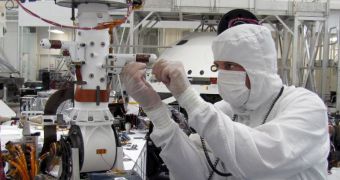When the Mars Science Laboratory rover, now called Curiosity, will roam the surface of our neighboring planet, it will provide daily weather bulletins for mission controllers on Earth. The readings will be taken by a Spanish instrument that will go on the explorations robot.
In addition to searching for signs of past life on the Red Planet, the MSL is also tasked with a variety of other missions, such as for example conducting exhaustive analyses on the current conditions on Mars.
At the same time, other instruments will search for clues as to how the environment looked like several billions of years ago, when experts say an ocean of liquid water existed on the planet.
By measuring daily and seasonal changes in the atmosphere, researchers will be able to derive long-term trends in Martian atmospheric conditions near Curiosity's landing site.
These data will come in handy if manned missions to the planet are to be conducted. Astronauts that will go there will need to know what type of weather they can expect at various landing locations.
The MSL will carry with it a complex suite of 10 scientific instruments. The Rover Environmental Monitoring Station (REMS) is just one of them. The instrument was built in Spain.
The construction efforts were coordinated by the country's Ministry of Science and Innovation and the Spanish Center for Industrial Technology Development. The device was integrated within the MSL in September, experts say.
The ensemble, which features sensors on Curiosity's mast, deck and inside compartments, is currently undergoing tests at the Pasadena, California-based NASA Jet Propulsion Laboratory (JPL).
Developing the external sensors was the most difficult part of the project, simply because these devices needed to be able to withstand wild temperature fluctuations without giving false readings.
“That was our biggest engineering challenge. The sensors will get very cold and go through great changes in temperature every day,” explains the principal investigator of REMS, Javier Gómez-Elvira.
The expert holds an appointment as an aeronautical engineer at the Centro de Astrobiología, in Madrid, an organization affiliated with the Spanish National Research Council and the National Institute for Aerospace Technology.
“We will gain information about whether local conditions are favorable for habitability, and we will also contribute to understanding the global atmosphere of Mars,” the expert says.
“The circulation models of the Mars atmosphere are based mainly on observations by orbiters. Our measurements will provide a way to verify and improve the models,” he goes on to say.
The Mini Cooper-sized MSL will launch next year, and is tentatively scheduled to land on Mars in 2012. Power is provided by a nuclear reactor, and so low temperatures are not expected to affect it.

 14 DAY TRIAL //
14 DAY TRIAL //